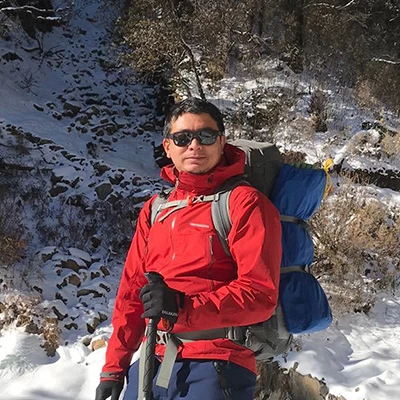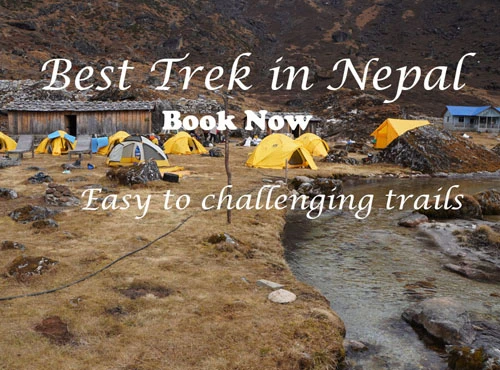At the heart of the Everest region in Nepal, Pikey Peak stands at an impressive altitude of 4,065 meters. What makes this trek truly unique is its incredible view point, it’s the only place in Nepal where you can see seven of the world’s eight thousand-meter peaks, including Mount Everest (8,848m), Kanchenjunga (8,586m), and Makalu (8,463m). If you’re looking to experience the majesty of the Himalayas without the crowds of more popular trails, the Pikey Peak Trek is the ideal choice.
Suitable for both beginners and experienced trekkers, this moderate-level trek offers a perfect blend of natural beauty and cultural richness. The trail takes you through vibrant rhododendron forests, traditional Tamang and Sherpa villages, and historic monasteries, providing a deep connection with nature and local traditions.
Pikey Peak also holds immense cultural significance. Every year on July 17th, thousands gather for a sacred festival where Rhododendron anthopogon is collected and burned in homes to bring positivity. This event, attended by shamans and locals, offers a rare glimpse into the spiritual practices of the Tamang, Sherpa, and Magar communities.
Whether you are drawn to the breathtaking sunrises, the diverse flora and fauna, or the chance to immerse yourself in Tamang and Sherpa culture, the Pikey Peak Trek promises an unforgettable adventure.
In this guide, we will explore how challenging the Pikey Peak Trek really is, what to expect along the journey, and essential tips to prepare for this untimate Himalayan experience.
How difficult is the Pikey Peak Trek?
The Pikey Peak Trek is considered moderately difficult, making it an excellent choice for both beginners and experienced trekkers. While the difficulty level depends on your fitness, preparation, and trekking experience, the trail is manageable for most. On average, you will walk 5-6 hours per day, with well-paced routes that aren’t too steep.
One of the trek’s advantages is its lower altitude compared to other high-altitude treks in Nepal. The highest point, Pikey Peak, stands at 4,065 meters, reducing the risk of altitude sickness. You will also spend two nights in Junbesi (2,700 meters), giving your body time to acclimatize.
Whether you’re a first-time trekker or a seasoned adventurer, the Pikey Peak Trek offers a rewarding experience without extreme physical demands. With proper preparation and a steady pace, you will find this journey both enjoyable and achievable.
What Makes the Pikey Peak Trek Challenging?
While the Pikey Peak Trek is considered to be of moderate challenging, there are a few things that might make it tough at times. Knowing what to expect will help you get ready and enjoy the trek more. Here’s what you need to know:
Altitude: Although Pikey Peak’s 4,065-meter elevation is lower than treks like Annapurna Base Camp or Everest Base Camp, it can still pose challenges. Proper acclimatization and staying hydrated are crucial to avoid altitude sickness, especially if you ascend too quickly.
Terrain: The trail features steep and rugged sections that can be tough on your knees and ankles, particularly during descents. Continuous uphill and downhill stretches in some areas can be tiring. Wearing sturdy trekking shoes with good grip and ankle support is essential for navigating these rough trails safely.
Weather: Weather conditions vary significantly depending on the season. Autumn(September to November) and Spring (March to May) offer the most favorable conditions, with clear skies and moderate temperatures. However, mornings and nights can be cold, so proper gear is a must. Sudden weather changes, such as fog, rain, or snow, are common. Monsoon and winter treks can be particularly challenging due to slippery trails.
Accommodation: Teahouses along the route provide basic lodging and meals, but don’t expect luxury. Facilities are simple, with shared bathrooms and limited food options. Hot showers and Wi-Fi usually come at an additional cost.
How to Prepare for Pikey Peak Trek?
Preparing for the Pikey Peak Trek takes both physical and mental readiness to handle the challenges along the way. With the right preparation, you will have a better and more enjoyable trek. So here are some points to considers to prepare yourself for the trek.

Physical Fitness:
The Pikey Peak Trek involves walking 4-6 hours daily on varied terrain. Building stamina and strength will make the trek more enjoyable. Here are some tips for physical preparation:
- Cardio Exercises: Activities like jogging, cycling, and swimming improve cardiovascular endurance, helping you manage long trekking days.
- Hiking Practice: Practice hiking on steep or mountainous trails to get used to the trekking conditions.
- Strength Training: Focus on exercises that strengthen your legs (e.g., squats and lunges) and core to help with steep ascents and descents.
- Stretching and Flexibility: Incorporate yoga or stretching exercises to increase flexibility, reduce injury risks, and improve your overall trekking experience.
Mental Preparation:
Mental readiness is just as important as physical fitness. Here’s what to keep in mind:
- Daily Challenges: Be prepared to walk 4-6 hours daily, often on uneven, steep, and rocky terrain.
- Basic Accommodation: Teahouses offer simple lodging and meals, with limited amenities. Hot showers and Wi-Fi may come at an extra cost.
- Weather Conditions: Sudden weather changes, including rain, snow, or fog, are common. Pack appropriate gear like a warm down jacket and rain gear.
- Limited Connectivity: Network connectivity is limited or unavailable in most areas, so prepare to disconnect and embrace the experience.
What to Pack for Pikey Peak Trek: Essential Gear and Tips
Packing the right gear is essential for a comfortable and successful Pikey Peak Trek. While the trek is not overly challenging, being well-prepared ensures you can fully enjoy the stunning Himalayan views and serene trails. Here’s a detailed packing list to help you get ready:
Clothing:
- Base layers (thermal tops and bottoms) – 2 sets.
- Down jacket (down or synthetic) – 1.
- Waterproof and windproof jacket and pants – 1 set.
- Trekking pants and shirts (quick-dry material) – 3 sets.
- Warm hat, gloves, and neck gaiter or buff – 2 each.
- Trekking socks – 4 to 5 pairs.
Footwear:
- Sturdy, waterproof trekking boots with good ankle support.
- Lightweight shoes or sandals for evenings at teahouses.
Accessories:
- Polarized sunglasses with UV protection.
- Sunscreen and lip balm.
- Hat or cap.
- Headlamp with extra batteries.
- Trekking poles.
Backpack:
- A comfortable, durable backpack (30-40 liters) with a rain cover.
- Duffle bag (provided by Moon Himalaya upon arrival).
Other Essentials:
- Sleeping bag (rated for -10°C or lower).
- Reusable water bottle.
- Water purification tablets or a portable water filter.
- Daily medications.
- Toiletries.
- Snacks (energy bars, nuts, dried fruits).
We have just covered some basic and essential gear above, but if you want to know more in details about the gear checklist for peak climbing in Nepal, click here.
How to Overcome Challenges During the Pikey Peak Trek
While the Pikey Peak Trek is not as demanding as some other high-altitude treks in Nepal, it still requires proper preparation to ensure a safe and enjoyable experience. Here are some key tips to help you overcome common challenges during the trek:
1. Acclimatization
Although Pikey Peak is not as high as other Himalayan treks, proper acclimatization is still crucial. Your itinerary includes two nights in Junbesi (2,700m), allowing your body to adjust to the elevation. This helps prevent altitude sickness and ensures you’re ready for the next stages of the trek.
2. Hydration and Nutrition
Staying hydrated is one of the most important ways to avoid altitude sickness. Drink plenty of water throughout the day and consume nutritious meals to keep your energy levels high. With Moon Himalaya Adventure, you don’t have to worry about food—our team provides balanced, hearty meals to fuel your journey.
3. Proper Gear and Clothing
Packing the right gear is essential for staying comfortable and safe. Here’s what we recommend:
- Base layers, down jacket, warm hat, gloves, and trekking socks to stay warm.
- Waterproof and windproof jacket and pants to protect against rain and wind.
- Trekking pants and shirts (quick-dry material) for comfortable walking.
- Sturdy, waterproof trekking boots with good ankle support.
- Personal care items like sunglasses, sunscreen, lip balm, and toiletries.
4. Pacing and Rest
Trekking is not a race, take your time and walk at your own pace. Our Pikey Peak Trek itinerary is designed to allow ample time for rest and acclimatization. Listen to your body: if you feel tired, take a break. Pushing yourself too hard can lead to exhaustion or injury.
How Hard is the Pikey Peak Trek? Insights from Trekkers
The Pikey Peak Trek is famous for being easy to reach and offering panoramic views, making it an ideal choice for trekkers of all kinds, from beginners to experienced ones. But how hard is it really? To get a clearer picture, let’s hear from those who have done the trek themselves.

Mr. Serge Mazet, a 77-year-old adventurer, successfully completed the Pikey Peak Trek without any issues, proving that this trek is suitable for all age groups. His story highlights the trek’s manageable difficulty and inclusivity.
Irenefrom Reunion Island, a first-time trekker, shared her experience: “Thank you for these wonderful 15 days! The ascent of Pikey Peak was filled with emotions, and the Lacchuman team made it unforgettable. This was my first trek in Nepal, and I’ll definitely return to explore more peaks with Moon Himalaya. Highly recommended!”
Amelie from France also praised the trek: “My first trekking experience in Nepal was incredible, thanks to the Moon Himalaya team. They took excellent care of us, ensuring everything was perfect. I can’t wait for my next expedition with them!”
These testimonials demonstrate that while the Pikey Peak Trek is achievable for beginners and older trekkers, proper preparation and a reliable guide team like Moon Himalaya can make all the difference.
Final Thoughts: Is the Pikey Peak Trek Hard?
Pikey Peak Trek is not the most challenging trek in Nepal, making it an excellent choice for trekkers of all experience levels. With proper preparation and basic trekking essentials, this journey is easily achievable. What makes it truly special is the combination of stunning Himalayan views, rich cultural encounters, warm hospitality, and serene trails that leave trekkers with unforgettable memories.

If you're ready to join on this incredible adventure, the Moon Himalaya Adventure team is here to guide you every step of the way.
Book your Pikey Peak Trek today by clicking here.
For any questions or assistance, feel free to reach out to us at WhatsApp or Contact Us anytime, we are available 24x7 for you. Don’t forget to explore our other trekking packages to find your next Himalayan adventure!




